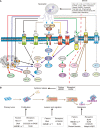Neutrophil Extracellular Traps in Digestive Cancers: Warrior or Accomplice
- PMID: 34868992
- PMCID: PMC8639597
- DOI: 10.3389/fonc.2021.766636
Neutrophil Extracellular Traps in Digestive Cancers: Warrior or Accomplice
Abstract
Characterized as a complex of extracellular DNA fibers and granule proteins, neutrophil extracellular traps (NETs) are generated specifically by neutrophils which play a critical role in host defense and immune regulation. NETs have been initially found crucial for neutrophil anti-microbial function. Recent studies suggest that NETs are involved in tumorigenesis and cancer progression. However, the function of NETs in cancer remains unclear, which might be due to the variation of research models and the heterogeneity of cancers. Although most of malignant tumors have similar biological behaviors, significant differences indeed exist in various systems. Malignant tumors of the digestive system cause the most incidence and mortality of cancer worldwide. In this review, we would focus on research developments on NETs in digestive cancers to provide insights on their role in digestive cancer progression and future research directions.
Keywords: cancer; digestive system; immunity; neutrophil extracellular trap; targeted therapy.
Copyright © 2021 Chen, Han, Qiu, Wang and Zheng.
Conflict of interest statement
The authors declare that the research was conducted in the absence of any commercial or financial relationships that could be construed as a potential conflict of interest.
Figures


References
Publication types
LinkOut - more resources
Full Text Sources

